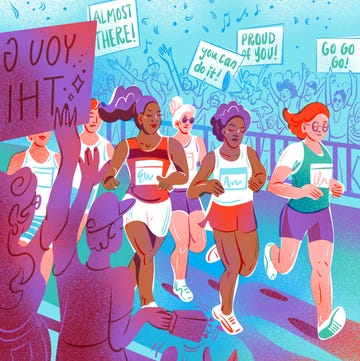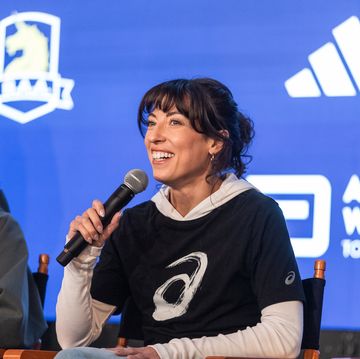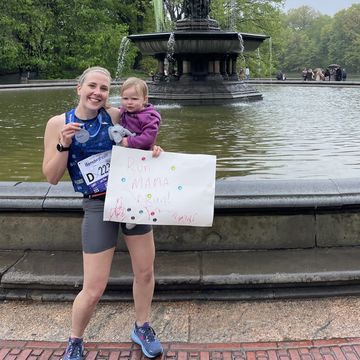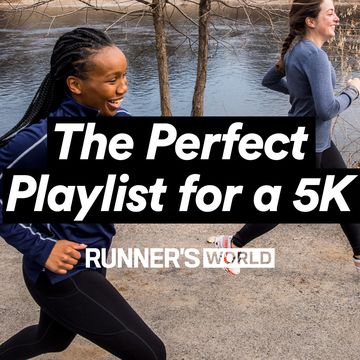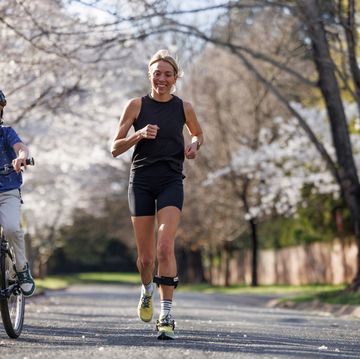Ethan Hawke, I feel your pain.
After running his first marathon in New York City last fall, the star remarked that plenty of fans had recognized him and cheered for him en route, “but when your hamstring starts to cramp up and your calf starts to cramp up, you really want to be anonymous.”
I’m no celebrity, but I likely attracted even more attention at the 2015 Marine Corps Marathon—the hot dog costume I was wearing is hard to miss. And the shouts of “NICE BUNS!” and “WEINER WOMAN!” and “TIME TO KETCHUP!” were lots of fun…until I was pushing through nausea and fatigue to crush the last 10K.
I’d come to race, after all—to set a Guinness World Record for, and I quote, “fastest marathon dressed as a fast food item (female).” While going for a Guinness record seems (and is) a wacky goal, it’s not that unusual—last year, Guinness World Records received applications for 660 running records. (Eighty-six of those attempts, including mine, were successful.)
The fun and silly challenge attracts athletes of all abilities: Professional ultrarunner Camille Herron, who set the fastest marathon dressed as a superhero (female) record with a blazing 2:48:51 in 2012, chose the goal as she was coming back from an injury. “It was a good time to do something kind of crazy,” she says. She ran (and won) the Route 66 Marathon in a pink, full-body Spiderwoman leotard. Friends waited near Mile 25 to hand off some Silly String, which she shot at the crowd as she broke the tape.
But you don’t need to be able to win races to set a costumed record: The time I needed to beat was 4:30—about 10 minutes slower than the average global marathon finishing time in 2014—and I managed it with a 3:57:49. You do need the ability to follow directions and to fill out mountains of paperwork. (Less-organized runners, see “Shortcuts to Greatness,” below.) If you’d like to claim your very own place in the most famous record book, suit up and read on.
1. CHOOSE YOUR RECORD
In order to set a costumed record, you need to be able to race at least 13.1 miles. “We feel that the challenge of distance running in costume starts at the half marathon level,” says Kimberly Partrick, Guinness’ Head of Records Management for North America.
If you can handle the distance, peruse the current records on GuinnessWorldRecords.com by searching “fastest marathon dressed” or “fastest half marathon dressed” (including the quotes). Every costume is eligible to have separate male and female records at the half and full marathon distances. For example, Alexander Scherz ran a 3:01:56 marathon dressed as a jester in 2012. There’s not yet a jester marathon record for women, nor a jester half marathon record for men or women, so attempts at any of those costumed records would likely get Guinness approval.
If you plan to ask Guinness to create a new category, it helps to keep some guidelines in mind, Partrick says: New records must be measurable, verifiable, and breakable in the future, and Guinness must be able to write rules so the record can be replicated anywhere in the world. In my case, I asked Guinness to create a “fastest marathon dressed as a hot dog (female)” category. When my application was approved, it was for “fastest marathon dressed as a fast food item (female),” with the definition, “a food item that is prepared and sold quickly. Examples include burgers, pizza, kebabs, etc.” I see now that a hot dog costume might be harder to come by outside the United States, where you can find the food at every ballpark.
2. CHOOSE YOUR RACE
Before you apply for a record, you need to have a race selected for your attempt. It needs to be exactly 13.1 or 26.2 miles and not downhill. A copy of the race’s USATF certification—which you can download from USATF.org—suffices as evidence of those two points, so it’s wise to choose a USATF-certified course. (If you choose a non-certified course, you’ll need to hire a surveyor, which creates an extra cost.) And, the race must be chip-timed, a requirement that helps Guinness ensure attempts take place only at legitimate events, Partrick says.
You’ll also want to reach out to the race director in advance, for two reasons: Some events prohibit costumes, so you’ll want to ensure yours doesn’t, and you’ll eventually need a statement from the race director to submit as part of your evidence. (See “Now Prove It,” below, for a complete list of the documentation you’ll need.) Make your intentions known early to avoid future problems.
Beyond that, there’s the obvious: Avoid warm-weather races, which are extra tough in costume, and you’ll likely have more fun at an event with solid crowd support.
3. APPLY TO GUINNESS WORLD RECORDS
You may wait up to 12 weeks for Guinness to process an application, so get the wheels in motion before you even begin training. It takes 10 minutes to create a profile on their site with your personal info, which record you’d like to attempt, and where and when you’ll try it.
If Guinness approves your attempt, you’ll receive two documents: a Guide to Your Evidence, which includes forms you’ll need to submit postrace, and a Specific Guidelines Pack, with a checklist of all the evidence you need to gather for your record. Study both carefully: “One of the biggest mistakes people make is not reading the guidelines and not really taking the evidence checklist seriously,” Partrick says.
Guinness will also send you a time standard you need to beat—even if you’re attempting a brand new record. The standard for new costumed marathon records is about 4:30, but it may be faster or slower depending on the costume and whether there’s an existing half marathon record for the same costume. Similarly, new half marathon records are based on existing marathon records, when they’re available.
Once your attempt is approved, you’ll need to send Guinness a photo of yourself in the costume to make sure it fits the standards they’ve laid out in your Specific Guidelines Pack. Mine said, “The costume must extend from at least the shoulders to below the waist and must fully encase the runner,” which sounds awfully uncomfortable. Luckily, my not-as-tight-as-sausage-casing costume got the thumbs-up, and I was set.
4. MAKE AN EVIDENCE PLAN
Much of what Guinness requires for evidence is straight paperwork. But, you need to be able to show that you wore your getup for the entire event: “If you just send us the race results, that does not prove that you wore your Mickey Mouse costume for the whole 26 miles,” Partrick says.
There are three Guinness-approved ways to do this: Film the entire race, have your photo taken at every mile marker, or run the whole way with at least two independent witnesses (that is, no coworkers, family members, or otherwise invested parties) who are willing to sign statements postrace confirming that you never took off your costume.
These methods each come with obvious downsides. If you’re filming, you’ll need to swap out batteries and/or camera cards along the way. Photos require you to tote a camera, stop at each mile marker, and enlist the help of others to take your picture. (Selfies are acceptable but must show face, shoulders, and the mile number—which becomes increasingly challenging and time-consuming as fatigue sets in.) Finding a couple running buddies to join you may be the least inconvenient option, but they need to be with you the whole way—if someone needs a long bathroom break or pulls a muscle, you’re doomed.
Gihan Amarasiriwardena, who set the fastest half marathon in a suit record (1:24:41) last December, enlisted a team to help him. Because he cofounded the apparel company Ministry of Supply—which, not coincidentally, makes suits out of tech fabrics—his business partners had good reason to step up. “Once we decided I was going for the record, we put together a Google Doc for everything we had to do,” he says. “We got footage at each mile marker—my teammates were stationed there to collect photo and video. I was able to do my part—do the workouts, get the miles in—not having to worry about the evidence.”
For my attempt, I managed to find a much-faster-than-me runner and experienced pacer from my area who was registered for Marine Corps but didn’t have a time goal. He volunteered to run with me and take photos at every mile marker, but he also fought crowds at aid stations to fetch me Gatorade and water and gave me pep talks when I was feeling cooked. (Thanks, Chris!)
5. TRAIN IN THE COSTUME
You don’t want the day of your record attempt to be the first time you try to run in your costume. That said, be prepared for some weird looks.
“I did two training runs in my costume: One was on Halloween, so everyone was laughing and honking their horns,” Herron says. “I tried to do another later, and people were like, Doesn’t she know Halloween is over?”
Amarasiriwardena would run-commute in his suit from his apartment to his office in downtown Boston, along the same route as the subway. “A lot of times, people thought I was trying to catch the train,” he says. But the practice helped him realize what was missing from his getup: a clip to keep his tie from flapping.
To avoid excessive scrutiny from passersby, I “trained” by running a couple shorter races as the hot dog. I learned quickly that the hood of the costume tended to fall backward while I ran, so I safety-pinned the bottom of the hood to the top of my visor. Problem solved.
6. SET THE RECORD
If you prepared well, this is the easiest part of the process.
7. COLLECT AND SUBMIT YOUR EVIDENCE
Herron recalls shipping a box of evidence to Guinness headquarters in London after she set her record in 2012, but it’s all digital now: You’ll need to upload witness statements, photos, video, links to media articles, and whatever else might help prove you succeeded to the Guinness website.
“We’ve never heard of too much evidence,” Partrick says. “The better documented something is, the better chance you have of getting the record.”
I submitted everything Guinness required, plus a short video my running buddy took at the finish, my Garmin data, my buddy’s Garmin data, and a few media articles. And then, I held my breath and waited, knowing that it could take up to three months to hear back from Guinness.
Fortunately, I had a deadline for this piece, and once I contacted Guinness to tell them that, I received an email saying that my record had been approved and that my certificate was “in the post.” Though the final miles of the marathon were the wurst, to be frank, I’ve never felt like such a wiener.
Shortcuts to Greatness
Lack the time, patience, or organizational skills required to fill out a bunch of paperwork? Here are other options to set Guinness running records.
Hire an Adjudicator To skip the evidence-submission step, you can request that a private judge from Guinness—officially called an “adjudicator”—attend your event and verify your achievement on site. The downside? It costs $8,000, plus cash to cover the adjudicator’s travel expenses.
Run the London Marathon Guinness has a longstanding relationship with this race. Adjudicators are on site each year to verify new records as they happen—in 2015, 34 records were broken.
Run the Toronto Waterfront Marathon or Half Marathon In 2011, Guinness began its partnership with this race, which takes place October 16. Last year, just one record (fastest half marathon in a suit) went down here, though Amarasiriwardena broke it less than two months later.
Now Prove It
Collecting evidence and completing paperwork is half the battle. Here’s about what you can expect to have to provide if you go for a costumed running record.
Cover Letter The template included in the Guide to Your Evidence pack asks for basic personal information, why you went for the record, where and when you did it, and what other evidence you’ll be submitting.
Race Results A screengrab of your official results (including gun and chip time) will suffice.
Surveyor’s Report Or, a copy of the USATF certification, which can be found on USATF.org.
Two Witness Statements One must come from the race director. The other must come from an independent party—no family, coworkers, or other people with anything to gain from your success. If you chose to race with at least two other runners instead of supplying photo or video, each must fill out a statement in addition to the race director’s.
Video Evidence Required only if you chose to tape your entire attempt.
Photographic Evidence Required only if you chose to take photos at each mile marker.
Releases If you supply photo or video, whoever owns the content must sign a release allowing Guinness to use it.





